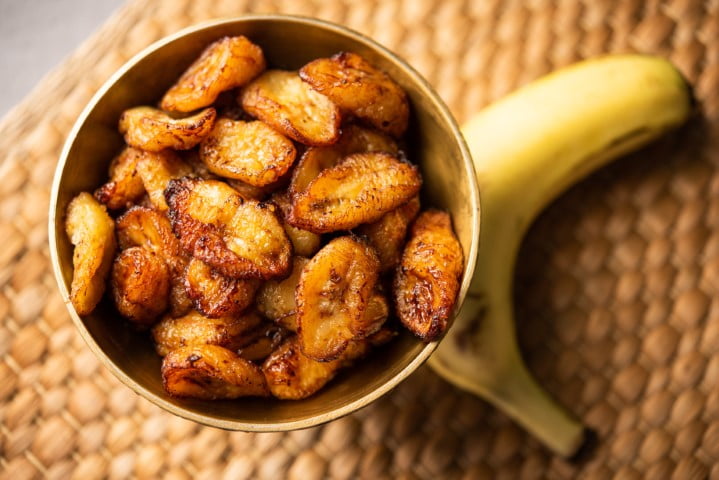Table of Contents
History of Platano Maduro
Plátano maduro, a popular dish featuring fried or baked sweet plantains, holds a significant place in Caribbean cuisine. Despite its strong association with the Caribbean, its origins can be traced back to Southeast Asia. Historical records suggest that plantains were introduced to Europe by Alexander the Great during his military campaigns in 327 B.C. While the plantain itself is believed to have originated in Southeast Asia, it found its way to the Americas through the voyages of Portuguese and Spanish explorers during the Age of Exploration. The precise birthplace of plátano maduro can be pinpointed to the tropical regions of the Americas, encompassing Central and South America, as well as the islands of the Caribbean.

Places Where the Platano Rules
Plátano maduros, or sweet plantains, are a versatile and beloved ingredient used in various ways across different countries in Latin America and the Caribbean. Here’s a breakdown of how they are commonly used in some of these regions:
Dominican Republic:
![]()
In the Dominican Republic, sweet plantains are often used to make sliced and fried until they’re crispy and golden on the outside and tender on the inside.
Cuba:
Maduros: In Cuba, plátano maduros are commonly prepared by frying ripe plantains in oil until they are caramelized and sweet, making them a popular side dish.
Puerto Rico:
Amarillos: Plátano maduros are often referred to as “amarillos” in Puerto Rico and are typically sliced and fried until they are sweet, soft, and caramelized. They are a common side dish and can also be served with rice and beans.
Venezuela:
Tajadas: In Venezuela, plátano maduros are sliced lengthwise, fried until golden, and served as a side dish or even as a topping for various Venezuelan arepas.
Colombia:
Aborrajados: Plátano maduros are also used to make aborrajados, where the ripe plantains are stuffed with cheese, battered, and fried to create a sweet and savory treat.
Caribbean Islands:
Plátano maduros are a staple in the Caribbean and are often prepared as a side dish by frying ripe plantains until they caramelize and become sweet.
These are just a few examples of how plátano maduros are used in various Latin American and Caribbean countries. Their versatility makes them a beloved and essential component of many regional cuisines, offering a delightful mix of sweet and savory flavors in different culinary traditions.
In these regions, particularly in countries like the Dominican Republic, Puerto Rico, Cuba, Venezuela, and many others, plátano maduro is a popular and cherished ingredient. It is often used in a variety of dishes, both sweet and savory. When plátanos maduros are ripe and turn a deep yellow to black color, they become sweet and are typically used in sweet preparations such as the recipe I provided earlier. However, they can also be used in savory dishes when they are green or partially ripe.
Platano Maduro Recipe (Step by Step)
Ingredients
- 6 ripe plátanos maduros (sweet plantains)
- 4 tablespoons of vegetable oil
- 10-12 whole cloves (one for each piece of plátano)
- 2 tablespoons brown sugar (adjust to taste)
- A pinch of salt
Steps to Make Baked Platano Maduro
Step 1 - Prepare the Plantains
- Preheat your oven to 400°F (200°C).
- Peel the plantains by cutting off both ends and making a shallow slit along the length. Remove the peel carefully.
- Cut the plantains diagonally into 1/2 inch thick slices. Thicker slices can help prevent them from becoming too mushy.
Step 2 - Add Cloves
- Insert a clove into the center of each plantain slice. The cloves will add a subtle, aromatic flavor to the plantains.
Step 3 - Coat with Oil
- Place the plantain slices in a large bowl.
- Drizzle the vegetable oil or melted butter over the plantains. Toss to coat each slice evenly.
- If desired, sprinkle the brown sugar and ground cinnamon over the plantains and toss again to coat evenly.
Step 4 - Bake the Plantains
- Arrange the plantain slices in a single layer on a baking sheet lined with parchment paper or a lightly greased baking dish.
- Bake in the preheated oven for 20-25 minutes, turning once halfway through, until the plantains are golden brown and slightly crispy around the edges.
Step 4 - Serve
- Remove the baked plantains from the oven and transfer them to a serving platter.
- Sprinkle with a pinch of salt if desired and serve immediately.

Enjoy. Serve your baked plátanos maduros as a delicious side dish or dessert. They can be enjoyed on their own or part of a snack board for an extra treat.
Froy Perez
UXMinify
Tips
- Plantain Ripeness: Use plantains that are ripe but not overly soft. They should be yellow with black spots but still firm to the touch.
- Clove Placement: Ensure the cloves are firmly inserted into the plantain slices to prevent them from falling out during baking.
- Even Baking: Turn the plantains halfway through the baking time to ensure they cook evenly and develop a nice golden color on both sides.
This baking method should help you achieve a delicious Plátano Maduro with a slightly crispy exterior and tender interior, infused with the warm aroma of cloves. Enjoy!
